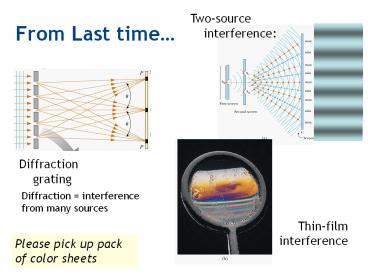From Last time - PowerPoint PPT Presentation
1 / 24
Title:
From Last time
Description:
Diffraction = interference from many sources. Single slit diffraction ... Diffraction: single slit interference ... Christian Huygens modeled this in 1690 ... – PowerPoint PPT presentation
Number of Views:16
Avg rating:3.0/5.0
Title: From Last time
1
From Last time
Two-source interference
Diffraction grating
Diffraction interference from many sources
Thin-film interference
Please pick up pack of color sheets
2
Single slit diffraction
Important parameter
- Interference-like pattern from a single slit.
Wavelength compared to size of aperture
Long wavelength wide pattern Short
wavelength narrow pattern
3
Diffraction single slit interference
- Huygens principle each portion of the slit acts
as a source of waves - These sources interfere according to path-length
difference.
4
Overlapping diffraction patterns
- Two independent point sources will produce two
diffraction patterns. - Too much overlap, resolution is lost.
- Image shows two sources clearly resolved.
Angularseparation
?
5
Diffraction-limited resolution
diffraction limit (? ?min )
not resolved (? lt ?min )
- Easily resolved
- (? gt ?min )
- For a circular aperture (e.g. lens)
6
Waves and geometry
- Interference and diffraction demonstrate that
light is a wave. - Doesnt always appear as a straight ray of light
but sometimes it almost does!
Geometric optics Tracing the path of light rays
7
What is a light ray?
- Light ray is a line in the direction along which
light energy is flowing.
Ray enters eye -gt you can see the light source
8
What does a light ray do?
- Light rays travel forever in straight line
unless they interact with matter (reflection,
refraction, absorption)
9
What about diffraction?
- Light really behaves as a wave
- The concept of a light ray is an approximation
i.e. a lie
Wavelength ltlt aperture size, rays are good
approximation
10
Light rays from point source
- Light rays are not always parallel.
- E.g. light bulb visible from all directions
- Rays must be traveling in all directions
Light ray perpendicular to local wavefront (crest
of wave).
11
Interaction of light with matter
- Absorption
Reflection
Refraction
And all occur simultaneously
12
Reflection and Refraction
- Direction of light can be changed by
- Reflection (lets you see an object)
- Refraction (transmits light thru object)
- at an interface between different materials
- Ray ? is the incident ray
- Ray ? is the reflected ray
- Ray ? is refracted into the lucite
- Ray ? is reflected inside the lucite
- Ray ? is refracted as it enters the air from the
lucite
Air
Plastic
13
When are materials different?
- For reflection/refraction
- materials are different if they have different
index of refraction - Light propagates at different speed in different
materials. - Due to interaction of electromagnetic wave with
atoms in material.
Material Index of refraction
Vacuum 1.00 exactly
Air (actual) 1.0003
Air (accepted) 1.00
Ice 1.31
Water 1.33
Ethyl Alcohol 1.36
Oil 1.46
Pyrex glass 1.46
Crown glass 1.52
Polystyrene plastic 1.59
Flint glass 1.66
Diamond 2.41
cspeed of light in vacuum
14
What do you think?
- Pyrex stirring rod (n1.46) dipped into beaker of
Wesson oil (n1.46). What happens to the rod?
- Appears dark
- Appears bright
- Appears invisible
- Appears curved
- Appears inverted
Beaker of Wesson oil
Pyrex stirring rod
No reflection/refraction if index of refraction
is same.
15
Reflection
- Angle of incidence angle of reflection
- Multiple reflections
- Apply ?i?r at each surface
- trace ray
16
Why ?i?r?
- Christian Huygens modeled this in 1690
- Said that each point on wavefront acts as source
of spherical wavelets - Superposition of wavelets gives reflected plane
wave such that ?i?r
?i
17
What about refraction?
- Refraction occurs when light moves into medium
with different index of refraction. - Result light direction bends according to
Snells law
18
Why Snell?
- Can analyze in exactly the same way
- Light moves at different speed in different media
?i
n1
n2gtn1
v2ltv1
19
Refraction angle
n1
Reflected ray
v2ltv1
n2 gtn1
slower in medium 2
faster in medium 2
n2gtn1Refracted ray bent toward normal
n2ltn1Refracted ray bent away from normal
20
Quick quiz
- Which of these fluids has the smallest index of
refraction(highest light speed)?
- Fluid A
- Fluid B
- Fluid C
- All equal
21
Numerical Example
- A beam of light is traveling underwater, aimed up
at the surface at 45 away from the surface
normal. Part of it is reflected back into the
water, and part is transmitted into the air.
Airn21.00
?2
Watern11.33
?145
22
Quick quiz
- A trout looks up through the surface at the
setting sun, and at the moon directly overhead.
He sees
n21.0
n11.33
- Moon directly overhead, sun parallel to water
surface - Moon directly overhead, sun 40 above water
surface - Moon 40 from vertical, sun parallel to water
surface - Moon and sun aligned at 40 from vertical.
23
Total Internal Reflection
- Is possible when light is directed from n1 gt n2
? refracted rays bend away from the
normal
- Critical angle angle of incidence that will
result in an angle of refraction of 90 (sin??
1)
24
Optical Fibers
The cladding has a lower n than the core
- Plastic or glass light pipes
- Applications
- Medicine endoscope (light can be directed even
if bent and the surgeon can view areas in the
body using a camera.) - Telecommunications































